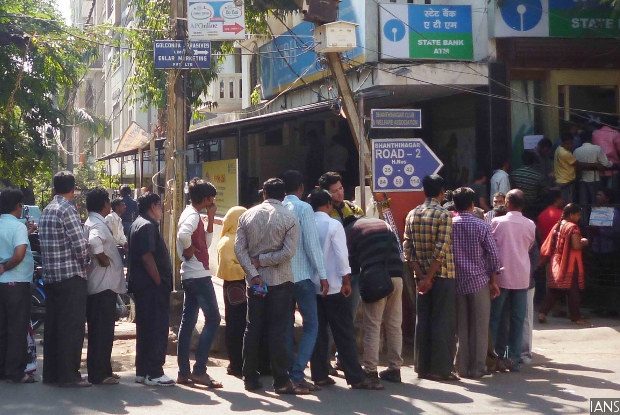In its first admission, the government has accepted that the demonetisation of Rs 500 and Rs 1,000 notes, announced by Prime Minister Narendra Modi on November 8, 2016, reduced economic activity–represented by growth in gross domestic product (GDP)–by 0.25%-0.5% relative to the baseline of 7%, according to the Economic Survey 2016-2017.

People queue up outside an ATM kiosk to withdraw cash in Hyderabad on December 21, 2016. The government accepted that the demonetisation exercise reduced economic activity–represented by growth in gross domestic product–by 0.25%-0.5% relative to the baseline of 7%
The forecast corroborates the growth estimate of 7.1% by the Reserve Bank of India, and is close to the estimate of 6.6% by International Monetary Fund.
GDP growth is expected to remain fairly stable at 6.75%-7.5% in 2017-18. “Even under this forecast, India would remain the fastest growing major economy in the world,” the Survey said.
“There have been reports of job losses, declines in farm incomes, and social disruption, especially in the informal, cash-intensive parts of the economy, but a systematic analysis cannot be included here due to paucity of macro-economic data,” the Survey admitted.
Finance Minister Arun Jaitley presented the survey to both houses of Parliament on the first day of the Budget Session 2017.
The survey highlighted three major risks to growth:
1) How far the effects of demonetisation could linger into the next financial year (2017-18), especially if uncertainty remains on the policy response;
2) Geopolitics could increase oil prices more than forecast; and
3) Trade tensions among major countries, triggered by geo-politics or currency movement.
“The one significant upside possibility is a strong rebound in global demand and hence in India’s exports,” the Survey said. “There are some nascent signs of that in the last two quarters. A strong export recovery would have broader spillover effects to investment.”
The Survey also highlighted the need for the formation of a public asset rehabilitation agency to resolve big and complex debt cases, Business Standard reported on January 31, 2017.
Divided into 14 chapters, the Survey discussed other issues, such as job creation, migration, health and fertility indicators and goods and services tax–an indirect tax that will replace octroi and other local taxes–expected to come into force in July 2017.
The first-ever estimates of internal work-related migration, using railway passenger data for the period 2011-2016, indicate that 9 million people migrated between states every year, the Survey said, highlighting the increased migration across the country.
The Survey devoted an entire chapter to the idea of universal basic income (UBI): “It is premised on the idea that a just society needs to guarantee to each individual a minimum income which they can count on, and which provides the necessary material foundation for a life with access to basic goods and a life of dignity.”
A UBI that reduces poverty to 0.5% would cost between 4-5% of GDP, assuming that households in the top 25% income bracket do not participate in the programme, the Survey said. “On the other hand, the existing middle class subsidies and food, petroleum and fertilizer subsidies cost about 3% of GDP,” an official release said.
“Time is ripe for discussion, and not implementation of Universal Basic Income (UBI)”, chief economic advisor Arvind Subramanian said at a press conference.
Courtesy: India Spend